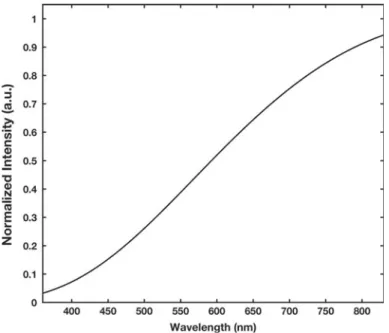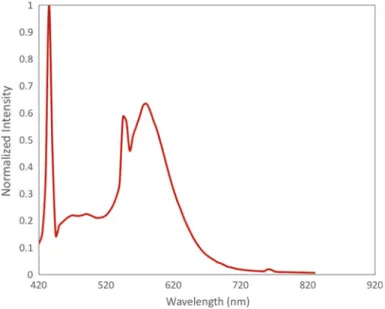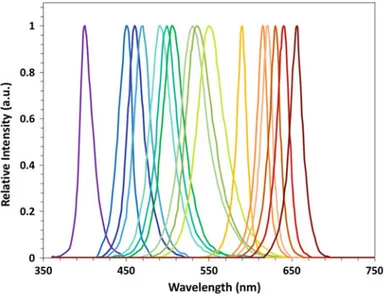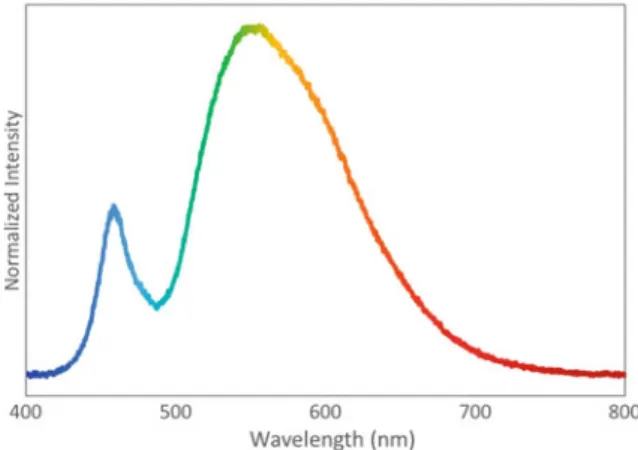Chapter 5
Common White Light Sources
Abstract In this Chapter we describe the features of common light sources. We first present the spectral features of the sun and discuss its colorimetric properties. Next, we summarize the properties of traditional light sources including incandescent lamps, fluorescent lamps, and high-pressure sodium lamps. Subsequently, we discuss the white light-emitting diodes of various types.
Keywords Sun
·
Incandescent lamps·
Fluorescent lamps·
High-pressure sodium lamps·
LEDsWe would like to start this section by summarizing the desired features of an artificial white light source. A good white light source should be able to render the real colors of the objects as good as possible. In other words, they should have high color rendering index or color quality scale values. Also the radiated intensity should overlap with human eye sensitivity function, which can be assessed using luminous efficacy of optical radiation. LER values close to 350 lm/Woptcan be considered photometrically efficient. It is here worth pointing out that the eye sensitivity function depends on the vision regime, which may vary according to the desired medium of working for the light source. In addition to these, a warmer white shade is desirable especially for indoor lighting to avoid disturbing the human biological rhythm. Quantitatively, this corresponds to correlated color temperatures (CCTs) smaller than 4000 K. Another critical parameter is of course the electrical efficiency of the light sources, which can be evaluated using luminous efficiency. Nowadays, the technology enables LE values above 100 lm/Welect, nevertheless, methods and processes are being developed to go beyond 150 lm/Welect.
5.1
The Sun
Before proceeding to the properties of artificial light sources, here we first would like to start with the sun, which has been the ultimate light source for all the terrestrial livings. Its spectral features have affected the evolutionary dynamics of our body. The average irradiance reaching the surface of earth is around 1 kW/m2[1]. At these © The Author(s), under exclusive licence to Springer Nature Singapore Pte Ltd. 2019
T. Erdem and H. V. Demir, Color Science and Photometry for Lighting with LEDs
and Semiconductor Nanocrystals, Nanoscience and Nanotechnology,
https://doi.org/10.1007/978-981-13-5886-9_5
28 5 Common White Light Sources
Fig. 5.1 Spectral irradiance of sun at the sea level and outside the atmosphere. Ref. [2]
energy levels, the human eye is obviously in the photopic regime where the cones dominate the vision. In the photopic regime, the average sensitivity of the eye peaks at 550 nm, which is also the value where the atmosphere’s transparency is the highest. Also a blackbody radiator at a temperature of 5250 K peaks at this wavelength which is the horizon color temperature of the sun light.
Since the sun can be classified as a thermal radiator, its radiation spectrum extends to long wavelengths where the human eye is no longer sensitive (see Fig.2.3), which makes replicating the sun spectrum in its entirety while designing a light source a bad idea in terms of the efficiency. Nevertheless, generating a broad-band light spectrum without thermal emission has been tricky and thus, utilizing blackbody radiators have been preferred for years (Fig5.1).
5.2
Traditional Light Sources
Among traditional light sources, the incandescent lamps are the ones whose radiation resembles the sun light most as blackbody radiators. The light emission mechanism in these lamps relies on heating a wire—typically made of tungsten—by applying electric current. The temperature of the wire reaches couple of thousands of Kelvins, possibly causing oxidation and evaporation of metal filaments. To minimize these effects, modern incandescent lamps are filled with inert gas. Being a thermal radia-tor, its emission spectra follow the characteristics of a standard blackbody radiator (Fig.5.2). Because blackbody radiators are considered as perfect color renderers, the color rendering index (or color quality scale) of incandescent lamps is 100. On
5.2 Traditional Light Sources 29
Fig. 5.2 The emission spectrum of an incandescent lamp at a CCT of 3000 K
the other hand, the overlap of their spectra with the eye sensitivity function remains low due to the long tail reaching far infrared. This unavoidably decreases the lumi-nous efficacy values to ca. 8–24 lm/Wopt [3]. Since the thermal radiation process is an extremely inefficient way of producing light, the power conversion efficiency of these lamps remains only at ca. 5%, which significantly drops the luminous effi-ciency. This is the main reason behind the current ban of these lamps in various parts of the world [4–6].
Before the era of LEDs, the fluorescent lamps were the most efficient white light sources in the market. Even today, a significant portion of the energy-saving lamps on the market are fluorescent lamps. These lamps basically rely on the color con-version of ultraviolet light produced by low pressure mercury vapor through electric discharge mechanism. The short-wavelength radiation of mercury vapor is absorbed by the phosphors and converted to broad-band white light (see Fig.5.3for a typical spectrum). Modern fluorescent lamps use phosphors made of rare-earth ions as color converters. These phosphors have a high photoluminescence quantum efficiency (i.e., number of photons emitted per absorbed excitation photon) helping them to reach luminous efficiency values up to 100 lm/Welect. Depending on the composition of the phosphors, they can also have high color rendering index values and a warm white shade. Nevertheless, the lack of color tunability using phosphors does not enable to optimize all these performance parameters at the same time. Other important con-cerns regarding these lamps are the mercury content making their waste hazardous and the ultraviolet radiation stemming from the discharge of mercury vapor. Because
30 5 Common White Light Sources
Fig. 5.3 A typical cool white fluorescent lamp emission spectrum
of these shortcomings, alternatives for these lamps are in demand and today light-emitting diodes step forward as an important replacement.
Another widely used white light source is the high-pressure sodium lamps. Similar to fluorescent lamps, these lamps are also gas discharge lamps. At low pressure, sodium vapor emits monochromatic light close to 590 nm, while broadband emission is observed as the pressure increases (Fig.5.4). The white light of high pressure lamps comes from sodium-mercury amalgam. The yellow and turquoise light stems from the high-pressure sodium (HPS) whereas the rest of the emission comes from the mercury vapor. An important characteristic of sodium lamps is their high luminous efficiencies reaching 150 lm/Welect. Nevertheless, they have very low color rendering index making them less desirable for indoor lighting applications. Furthermore, these lamps cannot provide high luminance in mesopic vision conditions. This is due to their very low correlated color temperatures <3000 K because of strong yellow content. These lamps are often used in road lighting, probably because of their energy efficiency and high luminous flux measured in photopic regime. However, the visual regime of road lighting is different than photopic regime and thus, HPS lamps are far from satisfying quality lighting conditions.
5.3
White LEDs
There are two main methods of obtaining white light emission using light-emitting diodes (LEDs). The first approach is the multi-chip LED approach, where the white
5.3 White LEDs 31
Fig. 5.4 Emission spectrum of a typical HPS lamp
light emission is generated via the collective radiation of several LED chips (at least three of them for red, green, and blue). The second method makes use of the photoluminescence of a fluorescent material integrated on top of an LED chip emitting at a shorter wavelength. This phenomenon is known as the color conversion, wavelength up-conversion, or energy down-conversion.
5.3.1
Multi-chip Approach
In multi-chip approach, LEDs emitting in different colors are combined to obtain white light. Modern green and blue LEDs are fabricated using GaN/InGaN material system while AlGaInP is employed to realize high-quality red LEDs [7]. In Fig.5.5, we provide typical emission spectra of LEDs of different colors. These emission bandwidths of LEDs are typically around 20–25 nm. Owing to this narrow linewidth, all the colorimetric and photometric features can be optimized simultaneously by carefully combining LEDs of various colors. However, their main drawback is the cost of the electrical circuitry to drive these LEDs. Another important problem is the lack of material system enabling efficient green emission, which is referred to as the green gap problem. Although the current green and yellow LEDs still remain behind their blue and red counterparts, novel materials and techniques are widely being investigated to overcome this green gap.
32 5 Common White Light Sources
Fig. 5.5 Spectra of various LED chips with peak emission wavelengths ranging from 400 to 655 nm
5.3.2
Color Conversion Approach
Different than the multi-chip approach, the color conversion method relies on the excitation of color-converting materials by higher energy photons provided by a short-wavelength LED. Typically blue LED chips emitting around 450–460 nm and alternatively near-ultraviolet LED chips emitting around 380–400 nm are employed as the high-energy photon source. As color converters, most commonly rare earth ion doped phosphors, and more recently colloidal quantum dots are used.
Alternatively, there are several organic dyes and polymers that can be incorpo-rated in LEDs [7,8]. Despite their high quantum efficiencies, their narrow-band absorption limits the choice of the pump LED, and their low photostability is an important bottleneck for their use in commercial devices. Moreover, these organic materials usually have broad-band emission; thus, simultaneous optimization of all the colorimetric and photometric criteria becomes challenging.
5.3.3
Broadband Versus Digital Color Lighting
The rare-earth ion based phosphors are the most ubiquitously used color converters in modern white LEDs. They are incorporated into a garnet such as yttrium aluminum garnet (YAG) doped with rare-earth ions such as gadolinium (Gd), cerium (Ce) and terbium (Te) ions [9]. The emission spectrum of a typical white LED using phos-phor color converters is presented in Fig.5.6. As apparent in this figure, phosphors
5.3 White LEDs 33
Fig. 5.6 Emission spectrum
of a color-converting LED using phosphors made of rare-earth ions
typically possess broad emission spectra enabling the creation of white light when hybridized with a blue LED. This broadness, however, causes a photometric prob-lem as the tail of the emission spectrum reaches the near infrared region where the human eye is not sensitive anymore. This inevitably decreases the luminous efficacy of optical radiation. To overcome this problem, the spectra of these phosphors are tuned by controlling the ion concentration and composition so that the overlap with the human eye sensitivity function is maximized as much as possible. Combined with their near unity quantum efficiencies, this results in high luminous efficiency values reaching >100 lm/Welect. However, the ability to tune the emission spectra of these phosphors is very limited; therefore, optimizing all the colorimetric and photometric parameters at the same time is not possible.
All the color converters explained above share a common problem: The difficulty in tuning the emission spectra in order to optimize colorimetric and photometric performance. Reaching this goal is only possible when strategically designed com-binations of narrow-band emitters are used. Among the candidates of narrow-band emitters, quantum dots have an important place [10,11]. The chemical synthesis techniques enable precise control over their size and the particle size distribution governs the emission color and linewidth of their emission. Currently, all the visible regime can be spanned with these materials while the bandwidths down to 20 nm can be realized at the same time (see Fig.5.7). Furthermore, the photoluminescence quantum efficiencies close to unity have been obtained. Nevertheless, these quan-tum dots are usually made of Cd-containing components such as CdSe and CdS, which raises questions regarding their widespread use. Although Cd-free quantum dots have been successfully synthesized, their quantum efficiencies remain low and emission linewidths are broader compared to their Cd-containing counterparts. In recent years a special class of these materials have attracted great interest in optics and photonics. These are known as perovskite nanocrystals because of their crystal structures. These materials also possess high quantum efficiencies and narrow emis-sion spectra; however, their low stability is a major challenge in addition to the Pb content in efficient perovskite emitters. As an alternative, colloidal quantum wells
34 5 Common White Light Sources
Fig. 5.7 Normalized
photoluminescence (PL) spectra of semiconductor nanocrystal quantum dots of varying emission colors
of inorganic semiconductors have emerged within the last couple of years. Their most important feature is the extraordinarily narrow emission reaching linewidths as narrow as 8 nm. This narrow emission should enable fine tuning of the spectra; however, the biggest challenges avoiding their widespread use are (i) the inability to obtain their efficient solid films without significantly altering the optical properties, (ii) difficulties in realizing efficient quantum wells at any desired wavelength in the visible regime, and (iii) the heavy metal content (Cd) of efficient colloidal quantum wells.
References
1. “Tutorial: introduction to solar radiation.” [Online]. Available:https://www.newport.com/t/ introduction-to-solar-radiation. Accessed 30 Jul 2018
2. “Sunlight.” [Online]. Available:https://en.wikipedia.org/wiki/Sunlight. Accessed 12 Nov 2018 3. Agrawal DC, Leff HS, Menon VJ (1996) Efficiency and efficacy of incandescent lamps. Am J
Phys 64(5):649–654
4. Howarth NAA, Rosenow J (2014) Banning the bulb: institutional evolution and the phased ban of incandescent lighting in Germany. Energy Policy 67:737–746
5. Mills B, Schleich J (2014) Household transitions to energy efficient lighting. Energy Econ 46:151–160
6. Schielke T (2007) Energy efficiency with lamp technology. Energy efficiency and visual com-fort through intelligent design. ERCO Lichtbericht 83
7. Schubert EF (2006) Light-emitting diodes, 2nd edn. Cambridge University Press
8. Guha S, Bojarczuk NA (1998) Multicolored light emitters on silicon substrates. Appl Phys Lett 73(11):1487–1489
9. Graydon O (2011) The new oil? Nat Photonics 5(1):1
10. Erdem T, Demir HV (2013) Color science of nanocrystal quantum dots for lighting and displays. Nanophotonics 2(1):57–81
11. Erdem T, Demir HV (2016) Colloidal nanocrystals for quality lighting and displays: milestones and recent developments. Nanophotonics 5(1):74–95
![Fig. 5.1 Spectral irradiance of sun at the sea level and outside the atmosphere. Ref. [2]](https://thumb-eu.123doks.com/thumbv2/9libnet/5637452.112035/2.659.135.522.75.373/fig-spectral-irradiance-sun-level-outside-atmosphere-ref.webp)




